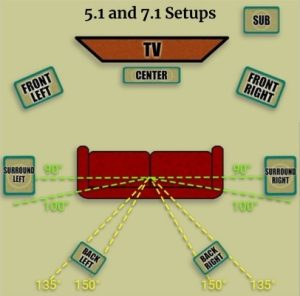Bookshelf Speaker Placement: How to Get the Best Sound from Your Setup
Despite their name, bookshelf speakers rarely deliver optimal performance when placed on an actual bookshelf. While the term suggests convenience and compact size, shelves are far from an ideal acoustic environment. In fact, correct bookshelf speaker placement can make the difference between muddy, uneven sound and a truly immersive listening experience.
These compact speakers are engineered to produce rich, detailed audio, but their full potential only comes through when positioned correctly. The surface they rest on, their height, spacing, and distance from walls all play critical roles in shaping sound quality.

Poor placement can degrade stereo imaging, obscure high-frequency detail, and create boomy or unbalanced bass, undermining the clarity and precision the very speakers were designed to deliver.
This guide explores why speaker stands matter, how strategic bookshelf speaker placement improves performance, and the simple adjustments that can help any bookshelf speaker system shine.
The Psychology Behind the Term “Bookshelf Speaker”
The term “bookshelf speaker” is something of a misnomer. It originally referred to the compact size of the speaker, suggesting it could fit conveniently on a shelf. Over time, the term stuck in consumer vocabulary, creating the misleading idea that this was the ideal location for them. In reality, these speakers are engineered to deliver optimal performance when placed in open space, and not crammed between books or up against a wall.
Bookshelf Speaker Placement for That Sweet Spot
Correct speaker placement is critical to achieving accurate and immersive sound. Positioning bookshelf speakers on stands allows for precise distance control and angling.

If they are your main speakers, ideally they should be placed so they form an equilateral triangle with the listener. This setup, often called the “sweet spot,” enhances stereo imaging, allowing each instrument and voice to be heard as though it originates from a distinct location on a virtual stage.
Spacing also matters. Speakers benefit from being placed at least 6 to 12 inches away from walls, helping to minimize bass reflections and resonance that can color the sound. Tilting or toeing-in the speakers slightly toward the listener can also improve focus and clarity.

In surround sound setups using bookshelf speakers, proper placement is key to achieving a balanced and immersive experience.
For 5.1 systems, position the surround speakers slightly behind and to the sides of the listening area at ear level to create a spacious, enveloping sound field.
In 7.1 configurations, two additional rear surround speakers should be placed directly behind the seating area, elevated about 1 to 2 feet above ear level. This added height helps with sound dispersion and enhances the sense of depth without interfering with the front soundstage or dialogue clarity.
What Happens When You Do Use a Bookshelf
Placing speakers directly on a bookshelf introduces a number of acoustic compromises. Shelves and surrounding surfaces cause reflections that can smear sound detail and disrupt stereo imaging.
Close-proximity surfaces can create comb filtering effects, where certain frequencies cancel each other out or become exaggerated. This results in a less accurate and less engaging listening experience.
And the shelf itself can vibrate from the speaker’s output, especially at higher volumes or with bass-heavy content. If audio components like a turntable or CD player are on the same shelf, these vibrations can affect playback quality.
Can You Put Bookshelf Speakers on the Floor?
Putting bookshelf speakers on the floor is no better than placing them on a shelf. In fact, it can be worse. Floor placement puts the tweeters far below ear level, which significantly dulls high-frequency clarity. It also exposes the speakers to additional reflections from the floor surface, which can blur midrange detail and harm overall tonal balance.
If speaker stands aren’t available, sturdy furniture at the right height combined with isolation pads may offer a temporary improvement, but floor placement should be avoided whenever possible.
>> Looking for the Best Bookshelf Speakers? <<
Choosing the Right Speaker Stands
Speaker stands are designed to elevate speakers to the ideal listening height — typically so the tweeters are level with the listener’s ears when seated. This positioning allows the full frequency range, especially high frequencies, to be heard with maximum clarity.
When selecting stands, consider both height and stability. To find the right stand height, measure ear level when seated and subtract half the height of the speaker. Stands with adjustable height provide extra flexibility.
For best results, choose models with fillable columns to reduce vibrations and increase mass. Integrated cable management, sturdy base design, and top-plate padding are also useful features to look for.
Bookshelf Speaker Placement Checklist
For optimal sound from your bookshelf speakers follow this placement checklist:
- Are the tweeters at ear level when seated?
- Are the speakers placed an equal distance from the listener and from each other?
- Is there at least 6–12 inches of space behind them?
- Are they free of nearby reflective surfaces (walls, furniture, shelves)?
- Are they placed on stable, vibration-isolating stands?
- Have you tried toeing them in slightly toward the listening position?
If you follow those guidelines, you’ll be on the way to getting the best performance from your bookshelf speakers.
Bookshelf Speaker Placement: Final Thoughts
Bookshelf speakers are capable of remarkable sound, but only when placed with intention. Despite the name, a bookshelf is one of the worst places to put them, and the floor isn’t much better.
To truly unlock their potential, use high-quality speaker stands, pay attention to speaker positioning, and minimize acoustic interference. With these steps, a pair of well-placed bookshelf speakers can rival tower speakers in sound quality and realism.

I am a passionate and skilled car audio enthusiast with 15 years of experience in the industry. My journey started when I replaced my first set of factory car speakers, sparking a deep love for high-quality sound. Since then, I have worked as a representative for renowned brands like Kenwood and Alpine.
With a background in both retail and distribution, I have developed a comprehensive understanding of the car audio market. Currently a certified (MECP) installer in the Mobile Electronics industry, my expertise lies in delivering top-notch audio installations. My knowledge, coupled with my genuine passion, makes me the go-to professional for all car audio needs.
